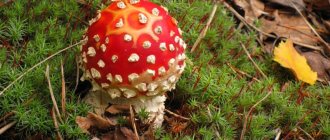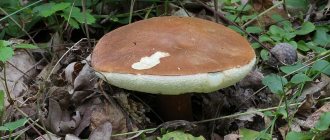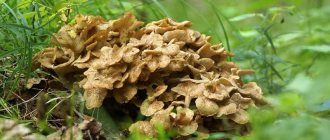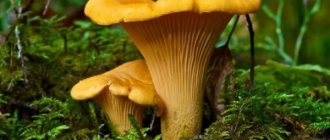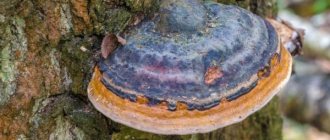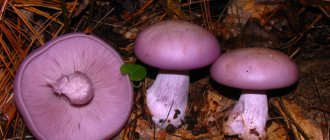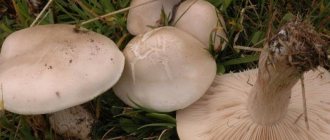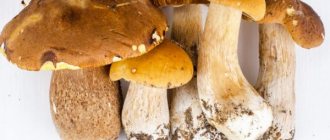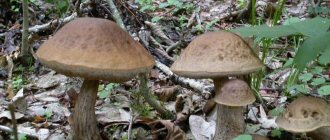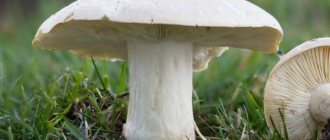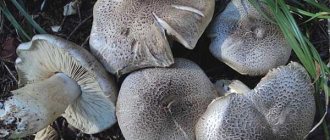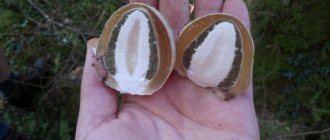A cute forest dweller with a brownish hat and a bandaged leg, as if tightly bandaged.
It is vaguely similar to honey mushroom, but belongs to a different family. Little known among mushroom pickers, but it has a set of interesting and useful qualities. This is a honeycomb-shaped row. What a mushroom is, what its natural and nutritional significance is, you will learn further.
Description of the open-shaped row (tied)
Latin name: Tricholoma Focale.
Family: Ordinary.
Synonyms: tied row, skull. Latin synonyms: Armillaria zelleri, Tricholoma zelleri.
Cap: with a diameter of 5 to 10 cm, sometimes reaching 12 cm. Young specimens have a convex-shaped cap, but as they grow older, it straightens and becomes convex-spread, and then almost flat. It can be fibrous-scaly, the edges are often cracked, and sometimes the remains of a flake-like blanket can be observed on their surface. The photo shows that the tied row has a reddish-brown, orange-red or brick-brown cap, the edges of which are lowered down.
Leg: long (from 4 to 10 cm) and thick (up to 3 cm in diameter), cylindrical, fusiform, sometimes narrowed at the base. At a young age, the structure is hard and dense, and at an old age it becomes hollow, longitudinally fibrous. The leg also has a ring-skirt, the surface above which is painted white and powdery. The lower part, extending from the ring to the very base, is the same color as the cap. Sometimes this area may be covered with small scales. The leg of the honey fungus is shown in the photo below:
Pulp: white, dense, elastic, has a faint smell of fresh flour and a slightly bitter taste, sometimes completely tasteless. As for the stem of the honey fungus, the flesh is fibrous. Under the skin, the flesh has a slight reddish tint.
The plates are notched, frequent, partially adherent to the stem with a tooth, white or slightly yellowish. In young specimens, the plates are completely hidden under a fibrous cover of a reddish-brown hue. With age, this blanket breaks, leaving marks.
Spores: ovoid or spherical, white.
Edibility: a conditionally edible mushroom, but abroad it is classified as poisonous. Can be eaten only after preliminary heat treatment. After boiling for 30 minutes, the broth must be drained without further use.
Similarities and differences: it is almost impossible to confuse it with any poisonous representative. The only species that is similar in appearance to the tied row is the white-brown row (Tricholoma albobrunneum). The latter also grows in groups, preferring pine trees. However, the mentioned types have noticeable differences: the white-brown row has a very strong bitterness and an unusual two-zone, smooth stem. Although there is information that this mushroom is boiled and then eaten. A photo and description of the honey fungus mushroom will help to correctly distinguish it from inedible similar species.
Edible or not?
The mushroom belongs to the category of conditionally edible. This means that you can eat it, but only after heat treatment - first, the mushrooms need to be boiled for 30 minutes, and then used as an ingredient in cooking. The broth remaining after cooking must be poured out - it cannot be used for making soups.
You may be interested in information about growing champignons in a greenhouse.
For the information of mushroom pickers, the honey fungus-like row is externally similar to the white-brown one, which is considered poisonous. A distinctive feature is that the white-brown row has an even two-zone stem, and the mushroom itself is very bitter. To avoid mistakes, it is advisable to carefully study the photos that can be found on the Internet before picking mushrooms.
Fresh rows can be stored in the refrigerator for no more than 3 days. Mushrooms also lend themselves well to drying and freezing, retaining their nutritional properties for six months. They can be preserved - then you can enjoy the fragrant, crunchy gifts of the forest until the next season.
Did you know? In Japan, 30% of medications for the treatment of cancer are developed based on medicinal mushrooms.
Is it possible to grow a row yourself?
Since mushrooms often have problems even in field conditions, it will be quite difficult to grow them yourself. Rower is a finicky mushroom that requires proper care, so achieving positive results is very difficult, and in some cases completely unrealistic. To plant edible rows, you should choose a moist area protected from the sun.
How to plant seeds (spores)?
The first thing you should do is go to the forest for a few mushrooms; the main thing is not to confuse an edible mushroom with a poisonous one. You need to choose a young, healthy mushroom without rot, yellow spots and worms. The mushroom caps are cut off and ground into powder; they contain many seeds. After which it should be soaked in potassium permanganate in a ratio of 1 gram per 9 liters of water. Leave for 5 hours.
Spores are planted in a mixture of horse manure, foliage and pine needles or on a substrate of champignon mushrooms. The pre-soaked mass is simply poured onto the bed and covered with substrate on top. Planting is done in the spring in order to get fruits in the fall.
How to grow mycelium (mycelium)?
Seedlings with mycelium can be obtained in several ways:
- Dig in the forest.
- Grow at home.
- Buy from a specialty store.
If you decide to dig in the forest, then it’s easy to do, you just need to find a clearing where these mushrooms grow and dig out the soil around them. A piece of 20 by 10 by 10 centimeters is enough. After which this land is planted in the garden and filled with substrate.
Buying mycelium is quite difficult, since it is rarely found on the market. In addition, there is a danger that the seller will slip in the wrong mycelium or a completely dead one that does not bear fruit.
Similar species
- Tricholoma robustum.
The similarity of this species with the bandaged row is so great that the differences are revealed only by molecular research and by studying the spores - they are somewhat larger. The mushroom is also rare, the taste and culinary qualities are identical.
- The row is white and brown.
The main difference between this type and the tied row is the smooth two-color leg, white at the cap and brown below. Most often, the color zones on the stem have a clear separation, but not always. There are no scales on the leg. It is considered conditionally edible.
1- Tricholoma robustum. 2- The row is white and brown.
Benefits and harm to the body
The benefits of giant row plant in folk and official medicine are known. Valuable properties are manifested due to the content of enzymes, vitamins, minerals, and amino acids in the composition of the plant product.
The obtained extracts from giant rowan help to cope with liver diseases, regeneration of organ cells occurs, and toxins are removed from the body. Dermatological ailments are treated with lotions from fruiting bodies.
The enzymes contained in the plant product have a positive effect on the gastrointestinal tract, saturate the brain with useful elements, and protect the body from fatigue.
Giant rowa can cause harm. It is not recommended for use by children under 12 years of age, people with individual intolerance, and nursing mothers. Fungi can trigger attacks of pain in patients with pancreatitis. Low acidity and gallbladder dysfunction are contraindications for the use of giant row.
Application in medicine
The rich chemical composition and beneficial properties of honey fungus are appreciated by folk healers who use the product in the treatment of various ailments. For example, infusions are made from mushrooms, which are then used in the form of lotions for skin diseases and wounds.
Did you know? In China and Japan, rowan extract is included in a mixture that helps in the fight against cancer of the reproductive system.
The drugs have a healing effect similar to the antibiotics chloramphenicol and streptomycin. To prepare it, you need to chop 100 g of mushrooms and pour 250 ml of water over them. Cover the container with mushrooms with a lid and leave to infuse for 2 days in a dark place. Then the infusion should be strained and stored in the refrigerator for no more than 3 days.
Mushrooms can be dried and ground using a coffee grinder. If large fragments remain, the composition is sifted. Skin lotions are made from mushroom powder to help eliminate acne, excess oiliness and irritation.
You can prepare a healing ointment from the rows - it is used for rubbing and compresses for joint pain and arthritis. The mushrooms need to be cut, placed in a jar, closed with a lid and placed in the oven on the lowest heat for 8 hours. After this, the mushrooms need to be thoroughly mixed until a homogeneous mass is obtained.
Important! Do not combine the use of rows with alcoholic beverages
-
this can cause severe poisoning.
Not only traditional medicine is interested in row mushrooms - mushrooms are also used in pharmacology, including them in the composition of antiviral, antibacterial and other useful drugs. In the 90s of the last century, a new branch of medicine was created - pharmaceutical mycology, which develops drugs based on fungi.
Interesting facts about rowing
- Gray row
. The cap is gray, convex at first, then with a flattened tubercle in the middle, the plates are tightly set, milky white. Additional names: pine pine, streaked, green grass, poplar. - Lilac-legged
. The cap is white, but the leg has a lilac tint, the cap is smooth, flat or curved. Common names: blueleg, two-color, blue root. “Disguised” as honey fungus. - Earthy or ground row
. Gray cap in the shape of a cone, sparse plates, hollow stem. It grows only in coniferous forests, including the Caucasus. - Mongolian young rower
. It is similar in appearance to a porcini mushroom and differs only in the reverse side of the cap - it has frequent white plates. In an old mushroom, the cap becomes brown and flattened, the edges bend upward. In Mongolia, it is widely used for medicinal purposes in treating infectious diseases and lowering blood sugar levels. - Japanese pine mushroom or matsutake
. Valued for its taste. The caps are light to dark brown; in older mushrooms they crack. The leg has brown spots and a white collar on top; the bottom of the leg is completely brown. The popular names in Russia are shod or spotted. This mushroom is one of the most expensive; dishes made from it belong to haute cuisine. - Giant row
. Outwardly, it does not look like a lamellar mushroom, the diameter of the cap is up to 20 cm, the edges of the young mushroom are tightly pressed to the thick stem, the old mushroom has a cap with raised edges. It grows in Japan and... in Africa. The plates are wide, white, and when broken, the flesh of the mushrooms turns red. - The row is yellow-brown
. Smooth light brown color, with light yellow plates. Unlike the above mushrooms, the taste is bitter. It grows only under birch trees. - Crowded row
. It grows in colonies, has low edible quality, and is not popular among mushroom pickers. The color of the cap is off-white to light brown, the legs are light, straight or swollen. - May row
. Light beige cap, whitish with yellowish stem. The pulp is fleshy, the plates are first white and then light yellow. The taste is floury. - Poplar row
. The convex, fleshy, glossy brown cap expands as it ripens; the flesh under the skin is pinkish; in older mushrooms it darkens. The mushroom is conditionally edible. - Purple row
. Other names are blueleg, cyanosis, titmouse. The hemispherical cap of a mature mushroom bends inward, the purple flesh gradually becomes yellowish. The plates are also purple, the leg is light. - The row is open-shaped
. Visually similar to honey fungus, as the name suggests. The cap is yellowish-brown, the plates are pale pink.
Poisonous “individuals” of this species include:
- Ryadovka white or stinking - a white mushroom when young and with brown spots when mature;
- Soapy - no toxic properties, but when cooked it tastes like soap, so it is not popular among mushroom pickers, the cap is olive, the leg is dotted with red spots;
- Sulphurous, sulphurous, sulfur-yellow - the cap is yellowish, with a hole in the middle, emits the smell of hydrogen sulfide when broken;
- Pointed, mousey, striped - dark gray color of the whole mushroom, the flesh has a burning taste;
- Tiger or leopard - a wide cap with brown spots, curved edges, gray flesh.
Description and distribution locations of matsutake mushrooms
Matsutake mushrooms are described.
Places of distribution, collection season, differences from similar species, culinary processing. Useful and healing properties, contraindications. Not only Périgord and Piedmontese truffles are included in the list of the most expensive mushroom delicacies. They compete with matsutake mushrooms, which are extremely highly valued in Japan.
The cost of a single particularly successful copy can reach up to $100. Japanese gourmets claim that the taste of matsutake, collected under red pine trees in their native lands, cannot be compared with any foreign representative of this species.
However, matsutake can be found not only in the Land of the Rising Sun.
Description
Matsutake (in some transcriptions - matsutake), belongs to the family of Ordinaceae, the class of Agaricomycetes. Latin name: Tricholoma matsutake. Another name is shod row.
This edible mushroom has the following species characteristics:
- the cap is dry, initially smooth, then with fibrous adjacent scales, from 3 to 20 cm in diameter, rounded-convex with rolled edges, later flat, with a wide central tubercle. It is painted in light brown and walnut-brown tones, and often retains the remains of a fibrous blanket along the edge. At maturity, the cap cracks so that the light whitish flesh is visible;
- the plates are white or light cream, of unequal length. In young specimens with a small convex cap, the plates are completely hidden under a light cover;
- spores are brown, small, round;
- the leg reaches a thickness of 3 cm, a length of 20 cm, expanding club-shaped towards the base or, on the contrary, narrowing. Immersed deep in the soil. It is colored brownish and has an unevenly spaced fringed ring. Above it, the surface of the leg is light, powdery, below it is darker, with a brown pattern.
- The pulp is light, very dense, but not hard, with a unique smell, combining the aromas of cinnamon, fruit and pine resin.
Distribution and collection season
Translated from Japanese, “matsutake” means “pine mushroom.” Indeed, this highly prized delicacy grows under pine trees, sometimes in oak and broadleaf forests mixed with pine trees.
It has become a rarity on the Japanese islands, so the needs of local lovers of gourmet mushroom cuisine are partly met by imported supplies. "Pine mushroom" is collected in Korea, China, North America, Sweden and Finland.
It is found in the Southern Urals, in Siberian, Far Eastern, as well as in Belarusian and Ukrainian forests.
The mushroom, which grows in groups, often forming rings around pine trees, can be difficult to find because its cap, crowning a deep-set stem, barely peeks out from under the layer of foliage and needles. In addition, matsutake is demanding regarding temperature and humidity conditions and soil fertility. To guarantee a harvest of this mushroom, the following combination of factors is necessary:
- daytime temperature is not higher than 26 ºC, and night temperature is not lower than 15 ºC;
- the amount of precipitation in 20 days is 100 mm and above;
- well-drained soil without excess nutrients. If fallen leaves produce more humus, fruiting bodies do not develop.
The collection season under such conditions occurs in September-October and lasts no longer than 20 days. It is at this time that Japanese matsutake pickers go mushroom hunting. North American, Korean, Chinese, Finnish and Swedish producers are not far behind them, because prompt export of carefully packaged “pine mushroom” to Japan is a well-paying business.
Similar types and differences from them
Somewhat similar to matsutake is the capillary mushroom (Tricholoma focale), a little-known edible mushroom.
It also grows near pine trees, has a fibrous scaly cap in variegated brown tones, a fibrous ring on the stalk and fleshy light flesh.
However, unlike the “pine mushroom”, this row has a very short stalk, easily removed from the soil, and a distinct powdery smell.
Growing among Scandinavian pines, the tree row Tricholoma nauseosum has been found to be the same species as the famous matsutake. It was after this confirmation that the Swedes and Finns began to collect “pine mushroom” for export.
Primary processing and preparation
To preserve the famous aroma, matsutake is only rinsed or wiped with a damp cloth, trying to keep the skin intact. Only the very bottom tip of the stem is cut off.
Then they are boiled, stewed, fried and baked in all sorts of gourmet ways, and some connoisseurs thoughtfully chew them raw. In addition, matsutake is dried and pickled.
Only freezing and excessively long heat treatment are considered unacceptable - both processes irreversibly destroy the delicate and complex bouquet of aroma.
Useful and healing properties
The complex compounds that make up matsutake mushrooms have antiviral and anticancer effects, confirmed by laboratory studies. In addition, they lower blood pressure, normalize blood sugar levels and have no side effects.
In traditional Chinese medicine, these mushrooms are considered a good remedy for diseases of the gastrointestinal tract, a sedative and analgesic.
Matsutake extract is also used in cosmetology as a skin lightening agent and improves its condition.
Contraindications
As such, “pine mushroom” has no contraindications for use. The only problem may be individual sensitivity to the substances that are included in its composition. In addition, you should not cook collected mushrooms that have been stored for too long.
Matsutake, the precious and healing VIPs of the mushroom world, grows not only on the Japanese islands. Perhaps, in a warm and humid autumn, in the pine forests of the middle zone, this mushroom, growing in secretive but numerous groups, will give its incomparable aroma to successful domestic pickers.
Source: https://mirgribnika.ru/sedobnye/griby-matsutake.html
How to cook rows
You will need: rows, water for cooking, salt, a knife for cleaning rows
1. Place the newly collected forest rows out of the basket on a piece of newspaper and clean them of sand and dirt. 2. Remove wormholes and darkened areas of pulp on the stems and caps from the rows using a knife. 3. If the mushrooms are especially contaminated with forest debris, remove the skin from the caps of the rows, which can be easily removed with a knife. 4. Rinse the prepared mushrooms thoroughly under cold running water. 5. Pour cold water into the pan, add salt (based on 1 kilogram of mushrooms, 1 tablespoon of salt and 1 liter of water), a quarter teaspoon of citric acid, and bring the water to a boil. 6. Place the rows in boiling water and cook for 20 minutes over medium heat, covered. 7. 10 minutes after the start of cooking, add 6 black peppercorns, 1 bay leaf and, if desired, 2 buds of dry cloves. 8. Drain the water, place the rows in a colander, cool and use as intended.
Cooking recipes
Rowers are consumed boiled, fried, pickled, added to soups, sauces and casseroles. Caviar made from them is especially tasty.
Primary processing
After collection, the fruits are inspected, wormy specimens and forest debris are removed, and washed under running water. In case of severe contamination and to remove possible bitterness, they are soaked for 2–3 hours.
Cooking
This is the main type of processing. It is carried out in 2 stages, followed by draining the broth.
Ingredients:
- mushrooms – 1 kg;
- water – 1 l;
- vinegar - 1 tbsp. l.
Process step by step:
- Heat water, add vinegar.
- Place the mushrooms in the boiling mixture and simmer for 10 minutes.
- Drain the liquid.
- Drain the mushrooms in a colander and cool.
- Boil in a new portion of water with vinegar for 10–15 minutes.
- Rinse.
After this, the rows are prepared in various other ways.
Pickling
For 1 kg of boiled fruit you will need:
- water – 1 l;
- salt, sugar - 2 tbsp. l.;
- bay leaf – 3-4 pcs.;
- peppercorns – 4 pcs.;
- garlic – 1 clove;
- table vinegar 9% - 1 tbsp. l.
How to cook:
- Cook the marinade from the above ingredients for 15 minutes, at the end add another 1 tbsp. l. vinegar.
- Place the mushrooms in sterilized jars and pour in the hot mixture.
- Cool to room temperature, then place in a cool place.
The product will be ready in a month.
Frying
In this form, the rows are consumed as an independent dish and in combination with other relatives and potatoes.
Ingredients:
- boiled skulls – 250–300 g;
- vegetable oil – 3-4 tbsp. l.;
- onions – 2-3 pcs.;
- salt, spices - to taste.
Preparation:
- Peel the onion, chop it, fry until transparent.
- Add mushrooms, fry for 12–15 minutes until golden brown.
- Salt and season.
Salting (classic method)
Ingredients:
- rows – 1 kg;
- salt – 40–45 g;
- currant leaves, horseradish – 3-5 pcs.;
- bay leaf – 3-4 pcs.;
- dill umbrellas – 2 pcs.;
- black peppercorns – 6-7 pcs.;
- garlic – 3-4 cloves.
Preparation:
- Rinse the fruit bodies and soak in cold water for 10–15 minutes.
- Divide the horseradish leaves and dill umbrellas into portions, cut the garlic into thin slices.
- Place 1/4 of the spices in the prepared container, add a layer of mushrooms on top, and add salt.
- Alternate layers: spices and seasonings – rows – salt. The last layer is spices.
- Put under oppression.
- Store in a cool place.
The product is ready in 1.5–2 months.
Caviar from the row
Ingredients:
- mushrooms – 200-300 gr;
- onions – 1 large or 2 medium-sized heads;
- vegetable oil – 3-4 tablespoons;
- salt, spices - to taste.
Preparation:
- Peel, rinse and boil the fruits.
- Cool, drain off excess liquid.
- Pass through a meat grinder or grind in a food processor.
- Fry the onion in vegetable oil until light golden brown.
- Combine with chopped mushrooms, mix well, add salt and spices.
Interesting Facts
https://youtube.com/watch?v=Xccr0pbrPxE%3F
- There are almost 2,500 species of mushrooms belonging to the family of mushrooms. They are called “rows” because they grow very crowded, most often in rows.
- Before any cooking method, these mushrooms must be boiled for 20 minutes.
- You should not eat raw lyophyllum as it may cause stomach upset.
- It is best to salt the rows in the fall, during this period the fruiting bodies are the most elastic and dense. For salting, you need to choose young specimens, as old ones can be tough.
Ryadovka crowded is a tasty, aromatic representative of the family of the same name. If you correctly identify and then process this mushroom, you can not only treat your family and friends with a unique dish, but also make delicious preparations for the winter.
Use
After boiling with vinegar, honey mushrooms lose not only their bitter taste and floury smell, but also any aroma at all. However, the fruiting bodies retain their shape, density and characteristic “crispy” consistency. After heat treatment, mushroom caps are most often used for canning; they can be pickled or salted.
There are also recipes for fried meadowsweet, preparing mushroom caviar and various sauces from it. A short video on this topic can be viewed at the following link:
Useful properties of rowing
The beneficial effects of eating row dishes on the human body:
- Antibacterial and antimicrobial action: the rows have a detrimental effect on pathogenic microorganisms due to the biologically active substances in their composition - fomecin and clitocin;
- Immunomodulatory properties - isolates and removes free radicals;
- They have an anti-cancer effect and prevent the malignancy of atypical cells;
- Improves the functioning of the cardiovascular system;
- Activate the removal of toxins, cleanse the liver of toxins;
- Eliminate overwork, prevent the development of depression;
- They have anti-inflammatory properties;
- Normalize blood sugar levels;
- Stabilize blood pressure;
- Strengthen coronary vessels, stabilize blood supply to the brain.
What does a row mushroom look like?
In total, approximately 100 varieties of rows are known, among which there are poisonous mushrooms. Therefore, you need to know what edible, conditionally edible and inedible specimens look like. A description of row mushrooms and photos will help with this - further in the text.
Important! If a person is not confident in his knowledge and experience, it is better not to take a mushroom than to allow a situation that threatens health and life. The mushroom body of a row consists of a cap and a stalk
Externally, representatives of the rowan family are distinguished by variability of characters. The caps of young specimens in various species have the shape of a ball, cone or bell. In an adult mushroom, the cap straightens as it grows. Diameter - from 3 to 20 cm. It has a noticeable but small tubercle in the middle, and the edges can be wavy, straight, tucked or everted
The mushroom body of the row consists of a cap and a stalk. Externally, representatives of the rowan family are distinguished by variability of characters. The caps of young specimens in various species have the shape of a ball, cone or bell. In an adult mushroom, the cap straightens as it grows. The diameter is from 3 to 20 cm. It has a noticeable but small tubercle in the middle, and the edges can be wavy, straight, tucked or everted.
The skin of the mushroom, depending on the species, is dry, velvety or smooth, slippery with mucus, pure white or all shades of yellow, green, red, brown. As it develops, the color also often changes.
Under the cap of the tricholoma there are spore-bearing plates, which, depending on the type, are thin, often located, or sparse, thick, fused with the stalk. The spores themselves are smooth, elongated, whitish or transparent, and the spore powder is either white or brown.
The stem of the rows can be completely bare, scaly or weakly fibrous. Color pinkish-brown. Some varieties have purple. The shape of the legs of mushrooms of this genus is varied: cylindrical, club-like, thickened at the cap or at the base. The remains of the blanket protecting the spore-bearing layer, if present, are in the form of a fibrous ring under the cap.
Appearance and habitat
The mushroom row or talker forms fruiting bodies with a clearly defined division into a cap and a stalk. Representatives of the genus have a flat cap (this is typical for mature mushrooms, but in young ones it is hemispherical), with a lamellar hymenform, and differs in color in different species. The leg is long, cylindrical in shape.
Rowers are ground-based species of mushrooms. More often, the mycelium chooses soil near coniferous trees. Individuals grow in small groups. They can form ring colonies - “witch circles”. There are many places where row trees grow: they are forest, meadow, grow in groves and even parks.
Irina Selyutina (Biologist):
It is important not to forget that most types of rows are mycorrhiza-formers, which as symbionts prefer representatives of coniferous tree species, most often choosing pine and less often larch, spruce and fir. Only rare species of the genus form mycorrhiza with deciduous trees (beech, oak, birch). The habitat chosen is poor sandy or calcareous soils of coniferous and mixed forests.
The genus received its name because of the “predilection” of representatives to grow in rows or groups. In some regions of the Russian Federation they are even called “mice”.
Geographically, the types of rows cover the whole of Russia. The species also grows in Crimea. Crimean mushrooms are actively collected from early spring to mid-winter due to the warm climate. The main time for fruiting of the genus is autumn, because it is the autumn fruiting bodies that reach their peak of fleshiness and quantity. Some species appear in the spring, while others bear fruit until the cold weather. The row mushroom combines many species, the description of which will be useful to every mushroom picker so as not to send false mushrooms to the basket and then to the plate.
Benefits and harm to the body
Mushrooms have beneficial, medicinal properties for the body. All thanks to the chemical composition of the fruiting bodies. Clitocin and fomecin destroy pathogenic microorganisms and cancer cells, performing the functions of an antibiotic. In addition, the crowded rows contain:
- proteins;
- cellulose;
- carbohydrates;
- fats;
- glucose, fructose;
- vitamins: A, B, C, D2, D7 and PP;
- minerals potassium, calcium, copper, sodium, phosphorus, manganese, zinc, iron, selenium;
- polysaccharides;
- amino acids;
- ergosterol.
It is believed that regular consumption of crowded rows increases immunity, has a positive effect on the gastrointestinal tract, stimulates the regeneration of liver cells, and promotes the removal of waste and toxins. The positive qualities of forest plants do not end there. They also activate the cardiovascular system, normalize blood sugar and heart rate.
Chemical analysis of the pulp determined the main properties of the mushrooms:
- antibacterial;
- anti-inflammatory;
- antiviral;
- antioxidant;
- immunomodulatory.
Important! Crowded rows can cause diseases. Since mushrooms accumulate particles of heavy metals, pesticides, mercury
They should not be used for pancreatitis, low acidity, or gallbladder dysfunction. Raw rows lead to intestinal disorders. Old copies do more harm than good.
Inedible
Talkers have several inedible and poisonous varieties, the descriptions of which are definitely worth reading.
Inverted
The second name is lepista obrata. Description:
- cap diameter - 4-8 cm;
- color - brick or reddish-brown with a yellow tint;
- the surface is smooth, becoming shiny in wet weather;
- wide-funnel shape;
- the pulp is gray-yellow with a sour odor;
- the leg is cylindrical, often curved, rigid, and has the color of rust or red brick.
The inverted talker prefers to grow in pine forests on the forest floor or among deciduous trees, under fallen leaves. The first harvest occurs in August and disappears at the end of October.
Waxy
Grows in open sunny areas, in grass, in forest clearings where the soil is sandy. Fruits from late July to early October.
Young fruiting bodies are distinguished by a convex cap shape; in adult specimens it is spread out, with a small tubercle in the center. The surface is gray, smooth and matte, and begins to darken in damp weather.
The leg is cylindrical, solid, widened at the base, snow-white, measuring 5x1 cm. The pulp is dense, fragile, and exudes an unpleasant specific aroma.
Belesaya
A small poisonous mushroom - 2-5 cm, prefers to grow in forest areas under a cushion of leaves and needles. Fruiting is long - begins in mid-August and ends in November.
The cap is first convex, then spread, with concave thin edges. Young fruiting bodies have a powdery surface, which later becomes smooth and shiny. The color is snow-white with a slight pinkish tint.
The plates are thin, densely planted. When cut, the mushroom is white and exudes a pleasant aroma. The leg is whitish or yellow, often curved.
Whitish
The whitish talker is very poisonous
Another poisonous and dangerous mushroom, which is called bleached or meadow. Contains a large dose of muscarine, therefore it is considered dangerous not only to health, but also to human life.
Prefers to grow in forest clearings, pastures, and meadows. Fruiting season is summer-autumn.
The cap is gray, small (2-4 cm), convex or funnel-shaped, later spread out. The edges are often uneven and wavy. The surface is dry and smooth, covered with a white powdery coating. When the mushroom matures, the coating begins to crack and then the main color of the cap becomes noticeable - cream or reddish-reddish.
The plates are densely planted, thin, at first white, then become beige.
The pulp is white, with a mealy aroma. The leg is thin, thicker towards the bottom, white or cream in color.
Reddish
The second name is grooved.
At first the cap is convex, then becomes flat with a concave center. The color is reddish-red or cream, the plates are of the same tone. The surface of the cap cracks when it dries (hence why it is sometimes called cracking) and becomes lighter. The pulp is thin, with an inexpressive aroma. The first signs of poisoning appear 15-20 minutes after consumption.
The leg measures 2-3x0.4-0.8 cm, felt in the lower part.
